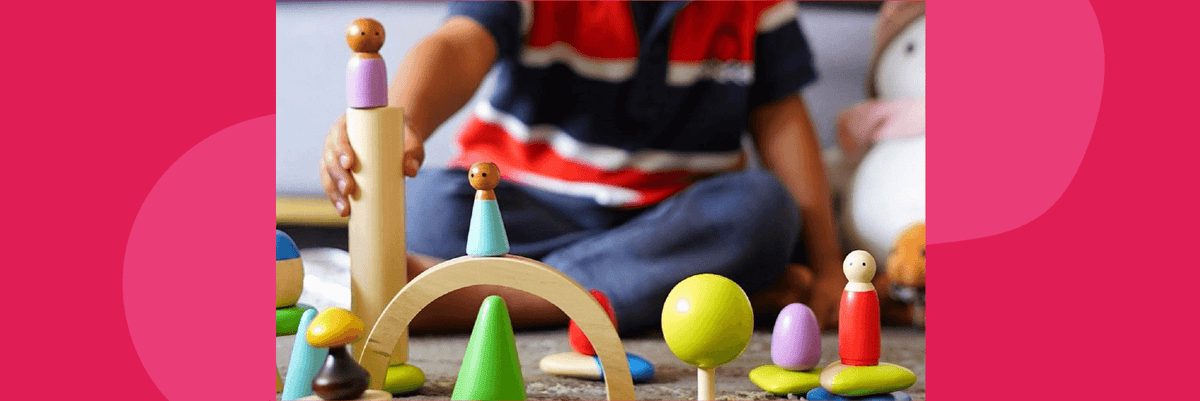“Is this really eco-friendly?” — chances are that you often ask yourself this question while purchasing anything today, including playthings for your child. But how can you tell if a toy is eco-friendly?
As toymakers who specialise in sustainable play, we understand that it can be confusing to get the complete picture. After all, it is not just about what a toy is made with, but how and where it is made, how your child can play with it, and how long they can use it for.
To simplify this, let’s look at the six most crucial aspects of an excellent sustainable toy. The more points a toy covers, the higher its ranking (don’t forget to note the bonus points!).
1. The toy is made of natural materials
When we think of eco-friendly toys, we think wooden toys. But a common question that arises is – how does cutting wood help the environment?
The answer is simple: Wooden toys are usually made from wood such as neem, beech, and oak. Not only do these grow quickly and in abundance, but a toy made of wood will also last a lot longer than a plastic toy. This means that you will have to buy replacements less often. Your child can play with a good wooden toy for years and pass it along to siblings or friends when they outgrow it!
Remember: Toys made of natural materials are also safe to put in the mouth! Check out our our range of wooden baby rattles & teethers to find the perfect one for your child. |
Compared to plastic toys, those made from natural materials are also less likely to pollute the environment during their life cycle. They consume less energy to create, do not release toxins into the environment, and can be disposed of sustainably.
2. It is an open-ended toy
An open-ended toy is simply one that your child can play with in different ways. Such toys usually have few instructions and no specified ‘winning outcome’.
Open-ended toys score big on sustainability as they actively engage children and keep presenting new ways to play, making them lasting additions to a toybox. For instance, a wooden stacker could be used to stack, play toss a ring, or to help your child learn counting and colours. They may even want to use it as a mountain or a pyramid in pretend play!
Bonus points: Can the toy’s packaging be used in play too? This eliminates waste, increasing its sustainable ranking!
Montessori or Waldorf? If you are confused between these two popular schools of open-ended toys, this blog explains it all! |
3. The toy grows with your child
We’ve already established that toys which last for a while are eco-friendly ones. While open-ended toys made of natural materials are a great start, the next step is to ask yourself – can my child use this toy in different ways as they grow older?
Good toys meet your child where they are at in their development and push them to the next level. So a toy that ‘grows with your child’ is one which lends itself to play in various ways as your child’s sensory, cognitive, and motor skills develop.
For instance, a set of High Contrast Flashcards can hone a baby’s visual skills, help a toddler identify shapes, and inspire a preschooler to build a story or draw the images! Similarly, a Montessori Spinner could fascinate a baby with its motion, encourage a toddler to use their hands to spin, and help a preschooler with colour recognition.
4. The toy encourages outdoor play
Where you play matters just as much as the toy itself! Running, jumping, and playing outdoors is fantastic to help children connect with the rhythms and moods of nature.
Playing at your local park with toys like a skipping rope or a balance board gives your child a chance to get some fresh air, take in the world around them, and relate to the larger ecosystem they are a part of.
5. It gets your child curious about nature
Toys that get your child curious about nature are just as important! Pretend playing with a forest set, lacing together farm animals, or sorting a jungle maze inspires children to notice the environment, respect other forms of life, and build a reverence for nature.
Bonus points: Is the toy’s design itself inspired by nature? For instance, our Wooden Stepping Discs incorporate the natural pattern of the wood into the toy to help children closely experience nature. Similarly, our Jungle Drum is created to produce rich sounds that are organically found in the natural world.
Looking for activities to get your child interested in the plants and animals around them? Our conversation with Wildlife Educator Kaustubh Srikanth has some great ideas! |
6. The toy is made locally
Finally, remember that local toys are an excellent way to reduce your carbon footprint. So while shopping for a toy, don’t forget to ask where the toy is designed, where its materials are sourced from, and where it is made!
Bonus points: Is the toy made by a local artisan? This not only helps keep traditional crafts alive, but each handmade toy will be a unique keepsake to treasure across generations!
Sustainable play is not just about toys!
While buying eco-friendly toys is a part of sustainable play, remember that there’s a lot more you can do.
Choose secondhand whenever possible, make your child’s toys using soft natural materials, or upcycle old objects into playthings. Imaginative play with what’s around or simple physical play like sports and running games are also great options.
Help your little one understand how they can add sustainable practices into their everyday lives and you’ll see them make more eco-friendly choices as they grow!


